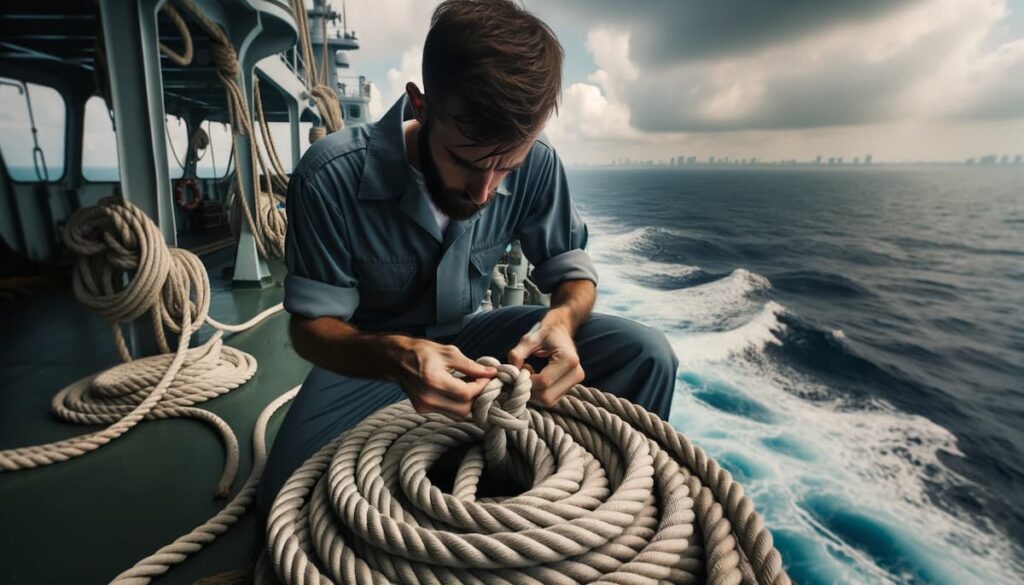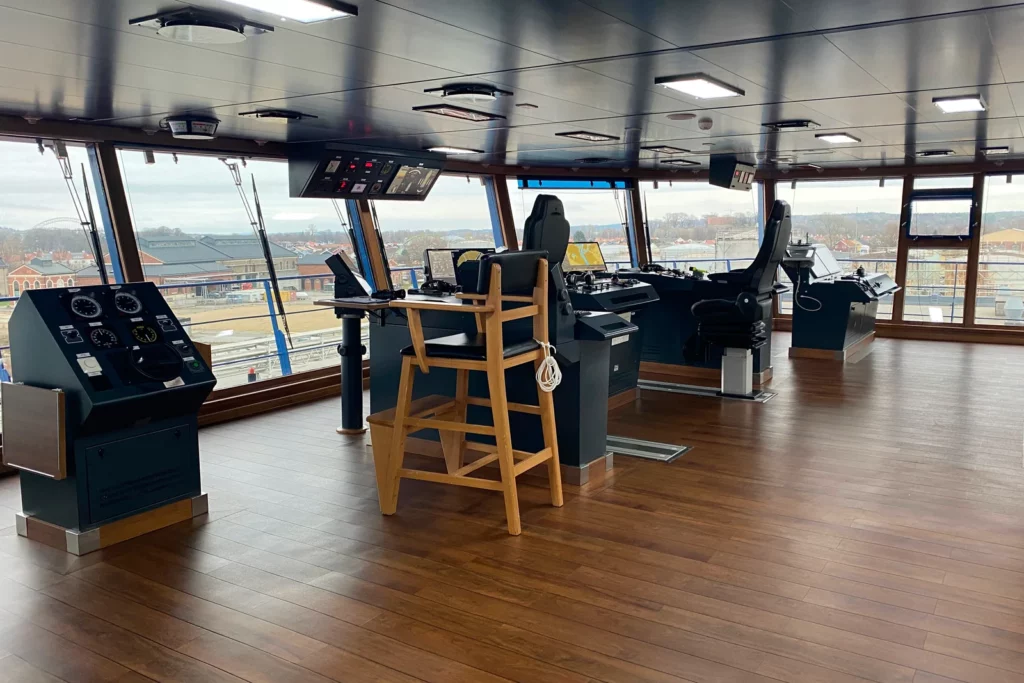Sailing is an art and a science. It’s about understanding the sea, preparing for its challenges, and mastering seamanship skills for safety on the water.
I transitioned from boardroom discussions to battling waves. This journey made the value of seamanship skills clear to me.
Seamanship skills go beyond managing a vessel. They encapsulate a mindset of respect, responsibility, and adaptability.
Mastering Key Seamanship Skills
Mastering key seamanship skills is vital as it ensures safety, enhances efficiency, and promotes self-sufficiency while at sea.
Seamanship skills equip individuals with the knowledge and capabilities needed to respond effectively to various maritime situations, navigate accurately, communicate effectively, and maintain the vessel in good working condition.
Moreover, they foster a sense of confidence and preparedness, which is crucial for tackling the unpredictable nature of marine environments.
This article delves into 15 essential seamanship skills. They are crucial for anyone embarking on a nautical adventure, be it a young graduate or a seasoned business professional.
Exploring Your Vessel Inside Out
Knowing your vessel is the cornerstone of safe sailing. It’s about familiarity with every nook and cranny, understanding the mechanics, and being prepared for emergencies.
It’s crucial not only to have a schematic but to intimately know your boat’s layout and regularly inspect essential parts like the steering gear to ensure safety and immediate response in emergencies.
Starting my career as a deck cadet on the dredger, the safety officer showed an excellent example of learning all escape routes by memorizing all turns, doors, and the number of ladder steps to safe areas. This knowledge may never be used or become lifesaving in case of emergency.
- Understanding the Layout:
- Familiarize yourself with the locations of crucial components like the engine, electrical systems, and emergency gear.
- Routine Inspection:
- Conduct regular checks to ensure all systems are functioning correctly. Look for signs of wear and tear that could escalate into bigger issues.
- Emergency Preparedness:
- Know where the fire extinguishers, life jackets, and first aid kits are stored. Ensure easy access to them in case of emergencies.
- Technical Know-how:
- Acquaint yourself with the basic troubleshooting of common issues. It’s beneficial to have a fundamental understanding of your vessel’s electrical and mechanical systems.
By exploring your vessel inside out, you build a foundation of safety and confidence, essential for tackling the unpredictable nature of the sea.
Maintaining Dead Reckoning Skills
In the realm of navigation, understanding basic principles is paramount. It not only amplifies the utility of our electronics but serves as a lifeline when they falter.

Dead reckoning embodies this essence. It’s about plotting an approximate course on a chart based on speed, time, and distance traveled from a known position.
- The Essentials:
- Familiarize yourself with the formulas: Distance (D) = Speed (S) × Time (T), Speed = Distance/Time, and Time = Distance/Speed.
- Practical Application:
- Regularly plot your position on a paper chart, especially when electronics are at your disposal. The frequency of this practice hinges on your proximity to land and potential hazards.
- Equip Yourself:
- Arm yourself with essential tools like dividers, parallel rules, and accurate charts, ensuring you’re well-prepared to navigate the traditional way.
Engaging in dead reckoning not only hones your navigational prowess but fosters a culture of learning and preparedness among the crew, nurturing the mariners of tomorrow.
Accurate Distance-Off Determination
Determining your distance from land or a navigational aid is essential. It not only aids in navigation but also provides peace of mind.
- Prepare Your Tools:
- A hand-bearing compass is indispensable for this task.
- Initial Bearing:
- Take a bearing when a notable point is at a 45-degree angle off your bow.
- Maintain Your Course:
- Hold your course, then take another bearing when the point reaches a 90-degree angle off your beam.
- Calculate the Distance:
- The distance traveled between the two bearings equals your distance off the point. For example, if you’ve covered 7.3 miles between bearings, you’re 7.3 miles off.
Incorporate a hand-bearing compass in your navigational toolkit. It’s a simple yet effective way to ascertain your distance off, ensuring you sail safely and confidently.
Operating in Heavy Seas
Sailing in turbulent waters is a test of skill and nerve.

Here are some tips to navigate through heavy seas safely:
- Know Your Vessel’s Limits:
- Understand the handling characteristics of your boat in various sea conditions.
- Prepare in Advance:
- Check weather forecasts and ensure your boat is equipped to handle rough waters.
- Adjust Your Speed:
- Adapt your speed to the wave conditions to avoid slamming into waves.
- Maintain a Safe Course:
- Steer at a safe angle to the waves to minimize the risk of capsizing.
- Stay Calm and Focused:
- Keep a clear head, and ensure everyone on board understands their roles.
Mastering the art of sailing in heavy seas enhances your confidence and ensures the safety of your crew and vessel.
Reading the Clouds for Weather Prediction
Observing clouds is an ancient yet effective method for anticipating weather changes. Here’s how you can decipher the sky:
- Learn Cloud Types:
- Understand basic cloud formations like cumulus, stratus, and cirrostratus, each indicating different weather patterns. A good example is reading storm clouds.
- Observe Cloud Movement:
- Cloud direction and speed can hint at incoming weather systems.
- Note Cloud Color and Height:
- Darker clouds may signify rain, while cloud height can indicate wind strength.
- Utilize Technology:
- Combine traditional observation with modern weather apps for more accurate predictions.
- Record Observations:
- Maintain a log to better understand local weather patterns over time.
Cloud reading, blended with modern technology, empowers you with the knowledge to anticipate weather changes, ensuring a safer sailing experience.
First Aid and CPR Administration
Being prepared for medical emergencies is crucial for the safety and well-being of everyone on board.
- Equip Your Vessel:
- Stock up on essential first aid supplies and ensure easy accessibility.
- Learn Basic First Aid:
- Familiarize yourself with common maritime injuries and how to address them.
- CPR Certification:
- Acquire CPR certification to handle cardiac emergencies.
- Regular Drills:
- Conduct first aid drills to keep skills fresh and effective.
- Local Emergency Contacts:
- Have a list of nearby maritime rescue centers and medical facilities.
Preparation for medical emergencies is a non-negotiable aspect of safe sailing, ensuring swift and effective response when every second counts.
Engine and Equipment Maintenance
Regular maintenance is key to prolonging your vessel’s life and ensuring safe voyages.
- Scheduled Check-ups:
- Adhere to a regular maintenance schedule for the engine and other crucial equipment.
- Knowledge is Power:
- Understand the basics of your vessel’s mechanical and electrical systems.
- Keep Spares:
- Stock up on essential spare parts to address unexpected breakdowns.
- Professional Inspections:
- Have professionals inspect and service your vessel periodically.
- Document Maintenance:
- Maintain a log of all maintenance activities for future reference.
A well-maintained vessel not only guarantees smoother sailing but also significantly lowers the risk of encountering problems out at sea.
Mastering Knots and Rope Work
Knots are the quintessence of sailing, holding the vessel together in harmony with the seas.

- Learn Essential Knots:
- Master basics like the Bowline, Clove Hitch, and Sheet Bend for various on-board tasks.
- Practice Makes Perfect:
- Regular practice ensures you can tie knots quickly and correctly, even under pressure.
- Understand Applications:
- Know which knot to use in different situations to ensure safety and effectiveness.
- Maintain Your Ropes:
- Regular inspection for wear and proper storage prolongs rope life.
- Educate Your Crew:
- Ensure everyone on board has basic knowledge of essential knots and their applications.
Mastering knots and rope work is fundamental to ensuring a safe and efficient sailing experience.
In today’s digital age, mastering electronic navigation is indispensable for precise sea voyages.

- Familiarize with Equipment:
- Understand the functionality and features of GPS, radar, and chart plotters.
- Regular Updates:
- Keep your software updated to ensure accuracy and reliability.
- Backup Systems:
- Have alternative navigation methods in case of electronic failure.
- Practice Safe Navigation:
- Utilize electronics to enhance, not replace, traditional navigation skills.
- Educate Your Crew:
- Ensure everyone onboard is versed in operating electronic navigation systems.
Leveraging modern electronics for navigation significantly elevates the safety and efficiency of your maritime journeys.
Adhering to Safety Protocols
Safety protocols are the backbone of secure sailing endeavors.
- Understand Regulations:
- Familiarize with maritime laws and regulations pertinent to your sailing area.
- Equip Your Vessel:
- Ensure your boat is equipped with necessary safety gear like life jackets, fire extinguishers, and emergency beacons.
- Emergency Drills:
- Conduct regular drills for man-overboard, fire, and other emergencies.
- Communication:
- Establish clear communication channels for onboard coordination and external assistance.
- Stay Informed:
- Keep abreast of weather forecasts and other vital information.
Adherence to safety protocols is a hallmark of responsible seamanship, ensuring a secure and enjoyable sailing experience.
Effective Communication Onboard and Beyond
Communication is the linchpin of maritime safety and coordination. Vital role plays timely and responsible onboard training during ship drills.
- Clear Onboard Communication:
- Ensure instructions and information are conveyed clearly among crew members.
- Radios and Signaling Devices:
- Utilize marine radios for communication with other vessels and authorities.
- Understanding Maritime Signals:
- Familiarize with standard maritime signals to convey messages accurately.
- Emergency Protocols:
- Establish clear procedures for communicating during emergencies.
- Regular Check-ins:
- Maintain regular communication with onshore contacts for safety.
Effective communication forms the bedrock of teamwork and safety, fostering a harmonious and secure sailing environment.
Maneuvering in Close Quarters
Navigating in restricted areas demands precision and understanding of your vessel’s handling.
- Know Your Vessel’s Dimensions:
- Being aware of your boat’s size and turning radius aids in tight maneuvering.
- Practice Makes Perfect:
- Regular practice in varied conditions hones your skills.
- Use of Fenders:
- Fenders help in preventing damage while docking or navigating close to other vessels.
- Throttle and Steering Control:
- Mastering slow-speed control and effective steering is crucial.
- Stay Calm and Focused:
- Keeping a cool head ensures precise decisions in tight situations.
Mastering close-quarters maneuvering is fundamental in ensuring safety during docking and undocking, or navigating crowded waterways.
Overboard Recovery Skills
Mastering overboard recovery procedures is paramount for ensuring safety at sea.
- Immediate Response:
- Quick action is crucial. Assign a lookout, mark the spot, and alert the crew.
- Maneuvering to the Person:
- Practice maneuvers like the Quick-Stop or the Figure-8 to approach the person swiftly.
- Recovery Equipment:
- Have equipment like a LifeSling or rescue platforms to aid in recovery.
- Reboarding Procedures:
- Establish clear procedures for assisting the person back on board.
- Regular Drills:
- Conduct man-overboard drills to ensure everyone is proficient in recovery procedures.
Efficient overboard recovery skills are vital in minimizing the risks and ensuring a quick and safe recovery during such emergencies.
Understanding the Rules of the Nautical Road
Adhering to maritime rules ensures safe and orderly sailing.
- Right of Way:
- Learn which vessels have the right of way in different scenarios.
- Signaling Intentions:
- Understand the signals for altering course or making way.
- Navigational Lights and Marks:
- Familiarize with the meaning of various navigational lights and buoy markings.
- Sound Signals:
- Learn the use of sound signals in fog or other low visibility conditions.
- Avoiding Collisions:
- Know the actions to take to avoid collisions at sea.
Grasping these nautical rules is essential for fostering safe interactions and navigation in the maritime domain.
Staying Updated on Weather Forecasts
Being weather-wise is critical for safe sailing.
- Reliable Sources:
- Utilize reputable weather forecasting services and apps.
- Regular Updates:
- Check forecasts frequently, especially when at sea.
- Understanding Forecasts:
- Learn to interpret weather data and forecasts accurately.
- Emergency Preparedness:
- Have contingency plans for unexpected weather changes.
- Educate Your Crew:
- Ensure everyone on board understands the basics of weather patterns and forecasts.
Staying updated on weather forecasts and responding accordingly is crucial for navigating safely and avoiding potentially hazardous situations at sea.
Now that you are acquainted with these essential seamanship skills, it’s your turn to take the helm.
Practice, learn, and evolve as you venture into the waves. A safer sailing journey awaits as you master these skills.
The sea may be relentless, but with preparation and knowledge, you can navigate through its challenges. So hoist the sails, embrace the learning, and embark on a journey of safe and exhilarating sailing adventures!
- Types of Gas Carriers as per IGC Code – April 22, 2025
- Wind-Assisted Propulsion Systems (WAPS): A Game Changer for Maritime Decarbonization – February 6, 2025
- 10 Boat Salvage Yards in California – January 25, 2025



